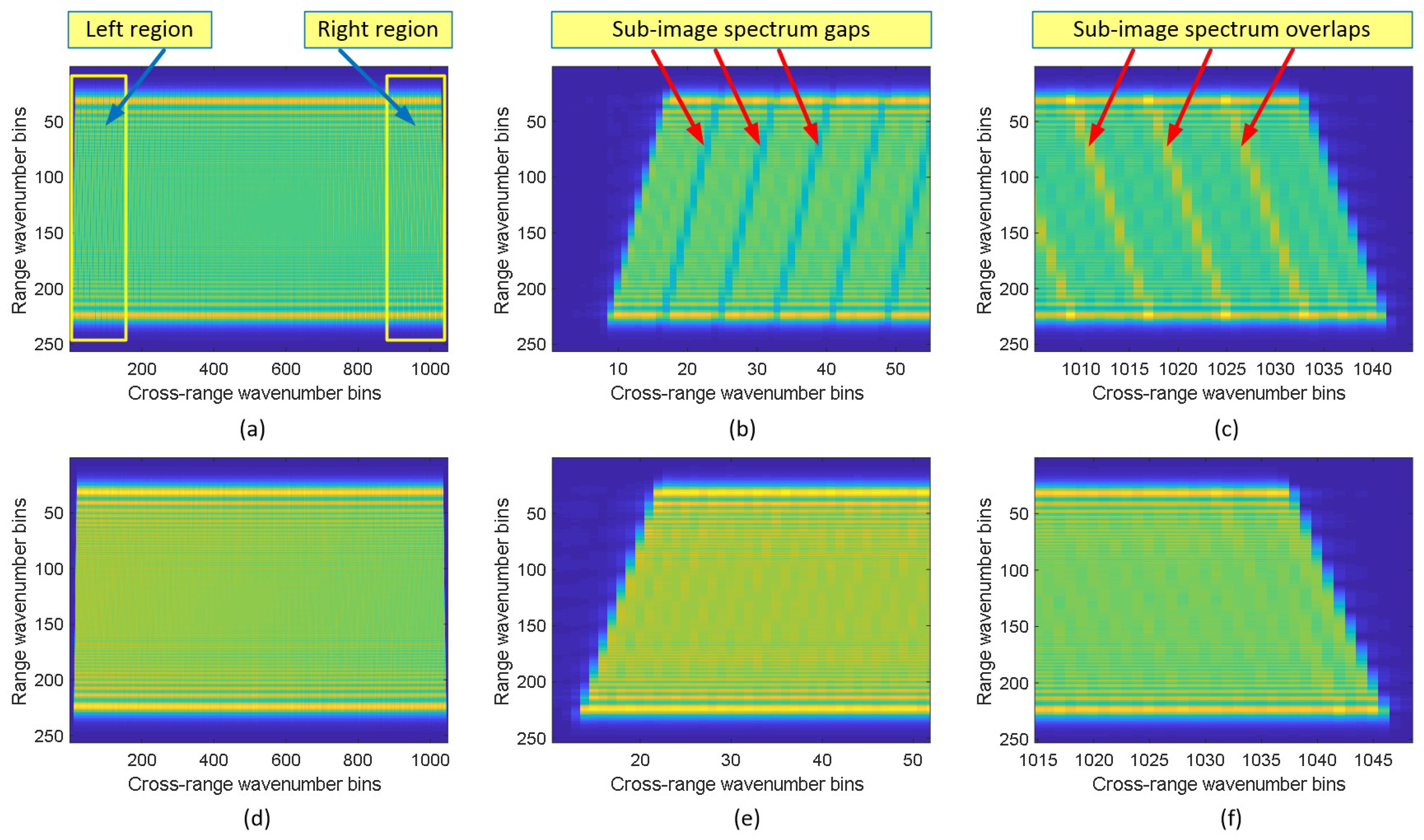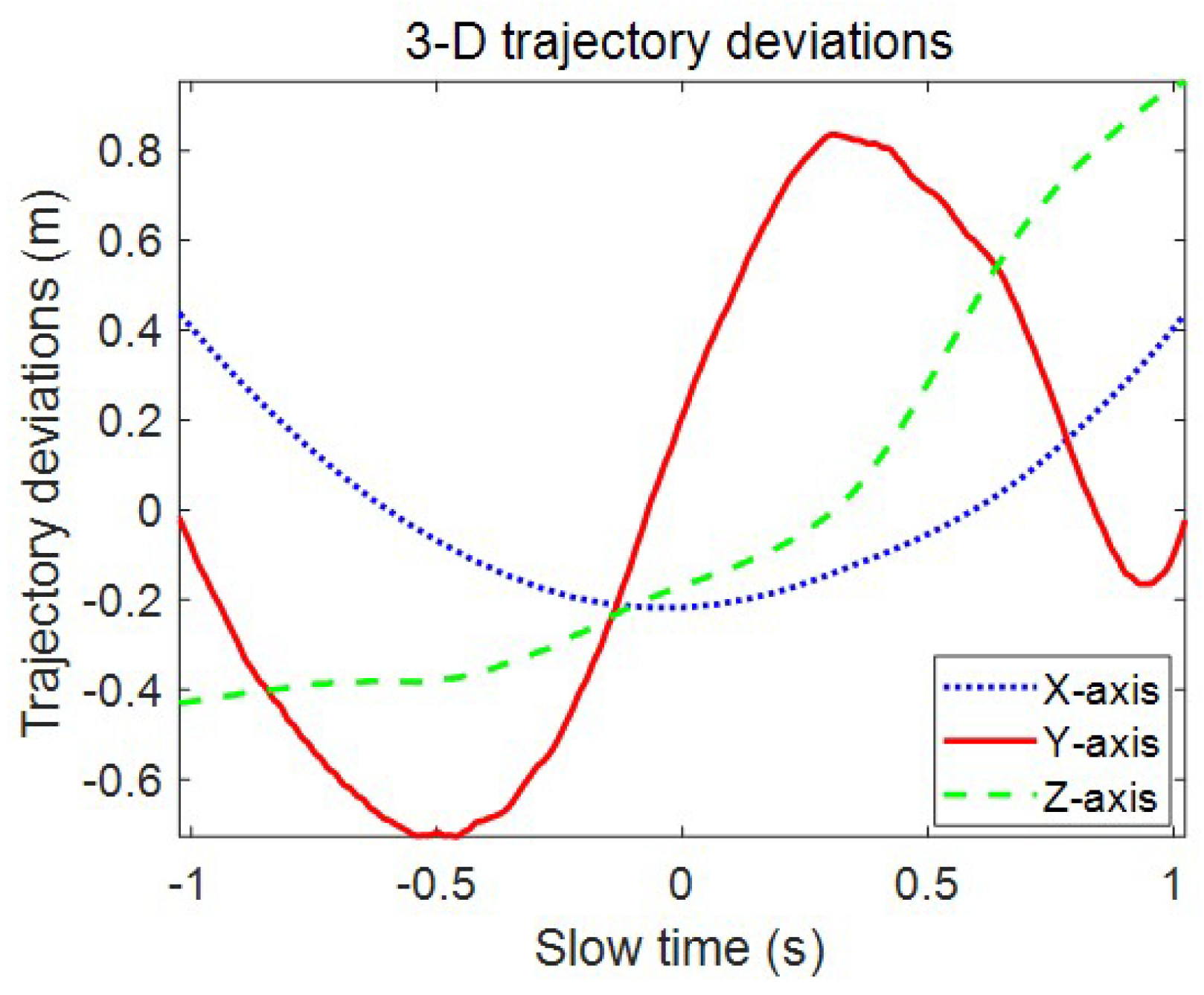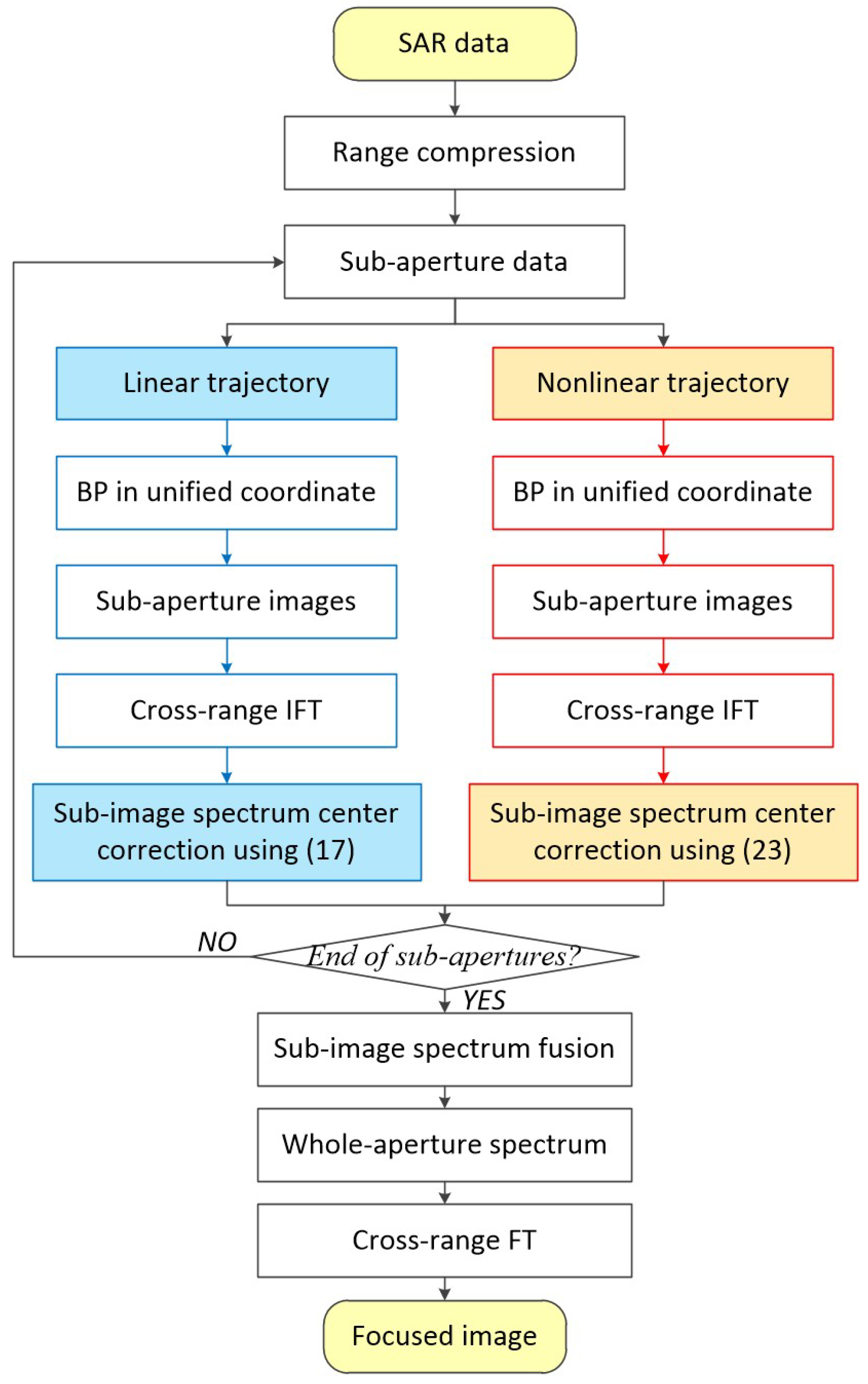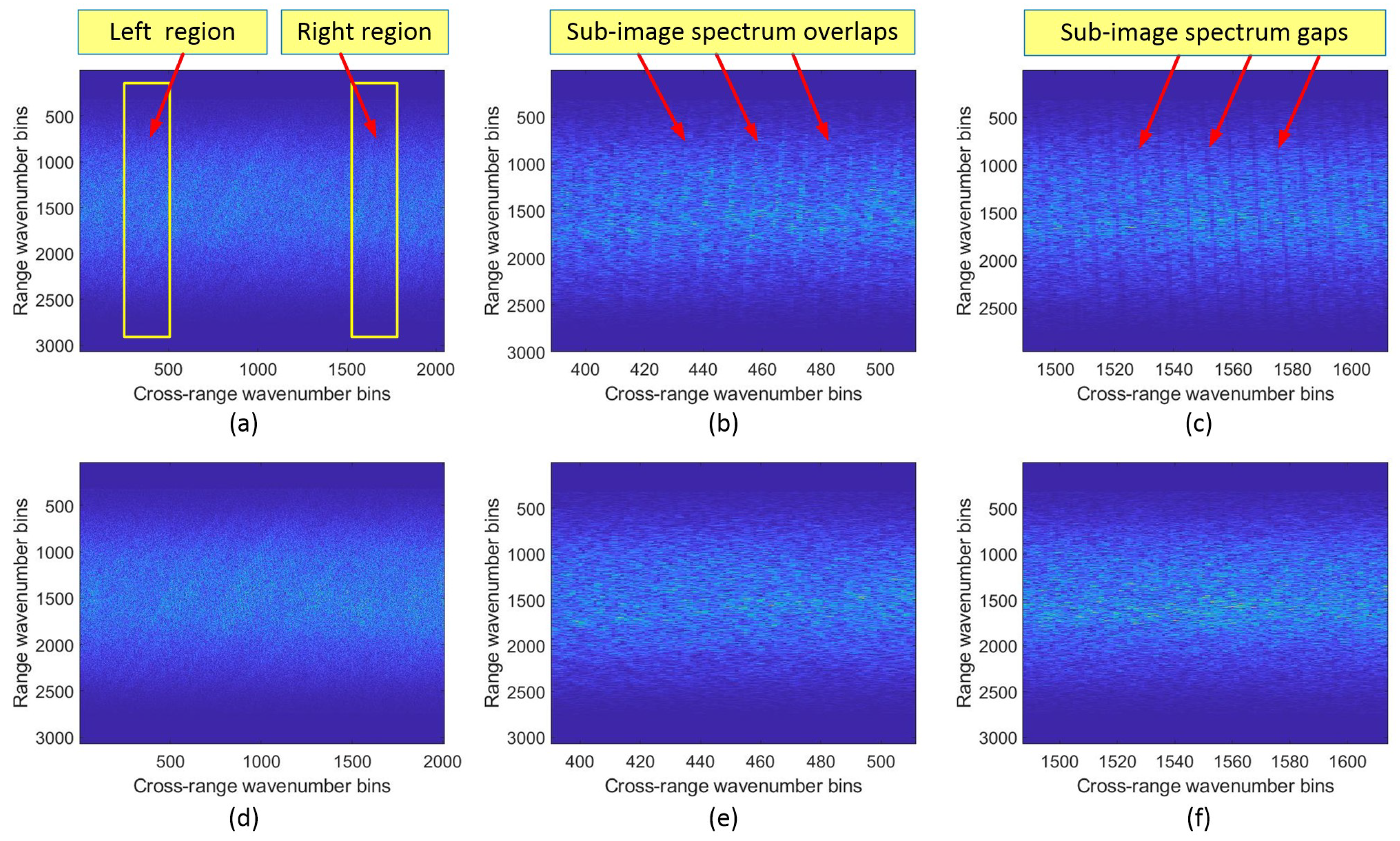Focusing High-Squint Synthetic Aperture Radar Data Based on Factorized Back-Projection and Precise Spectrum Fusion
Abstract
:1. Introduction
2. Signal Model
3. Review of AFBP
4. The Proposed HS-AFBP Algorithm
4.1. Linear Trajectory
4.2. Nonlinear Trajectory
4.3. Framework of The Proposed HS-AFBP Algorithm
- Sub-aperture division. After range compression, the whole aperture is divided into multiple sub-apertures with equal length.
- BP in unified polar coordinate. Sub-aperture data is backprojected into the unified polar coordinate according to the linear trajectory or nonlinear one, generating multiple sub-images.
- Sub-image spectrum fusion. Since the sub-image spectrum center is corrected precisely, the spectrums can be fused coherently to form a whole aperture spectrum.
- Cross-range compression. Cross-range FT is applied to the whole aperture spectrum, then the full-resolution image can be obtained finally.
5. Experimental Results
5.1. Dataset 1
5.2. Dataset 2
6. Conclusions
Author Contributions
Funding
Acknowledgments
Conflicts of Interest
References
- Cumming, I.G.; Wong, F.H. Digital Processing of Synthetic Aperture Radar Data: Algorithms and Implementation; Artech House: Norwood, MA, USA, 2005. [Google Scholar]
- Moreira, A.; Huang, Y.H. Airborne SAR Processing of Highly Squinted Data Using a Chirp Scaling Approach with Integrated Motion Compensation. IEEE Trans. Geosci. Remote Sens. 1994, 32, 1029–1040. [Google Scholar] [CrossRef]
- Tang, S.Y.; Zhang, L.R.; So, H.C. Focusing High-Resolution Highly Squinted Airborne SAR Data with Maneuvers. Remote Sens. 2018, 10, 862. [Google Scholar] [CrossRef] [Green Version]
- Sun, Z.; Wu, J.; Li, Z.; Huang, Y.; Yang, J. Highly Squint SAR Data Focusing Based on Keystone Transform and Azimuth Extended Nonlinear Chirp Scaling. IEEE Geosci. Remote Sens. Lett. 2015, 12, 145–149. [Google Scholar]
- Ran, L.; Liu, Z.; Li, T.; Xie, R.; Zhang, L. An Adaptive Fast Factorized Back-Projection Algorithm with Integrated Target Detection Technique for High-Resolution and High-Squint Spotlight SAR Imagery. IEEE J. Sel. Top. Appl. Earth Obs. Remote Sens. 2018, 11, 171–183. [Google Scholar] [CrossRef]
- Zhang, S.; Xing, M.; Xia, X.; Zhang, L.; Guo, R.; Bao, Z. Focus Improvement of High-Squint SAR Based on Azimuth Dependence of Quadratic Range Cell Migration Correction. IEEE Geosci. Remote Sens. Lett. 2013, 10, 150–154. [Google Scholar] [CrossRef]
- Liang, Y.; Li, Z.; Zeng, L.; Xing, M.; Bao, Z. A High-Order Phase Correction Approach for Focusing HS-SAR Small-Aperture Data of High-Speed Moving Platforms. IEEE J. Sel. Top. Appl. Earth Obs. Remote Sens. 2015, 8, 4551–4561. [Google Scholar] [CrossRef]
- Raney, R.K.; Runge, H.; Bamler, R.; Cumming, I.G.; Wong, F.H. Precision SAR Processing Using Chirp Scaling. IEEE Trans. Geosci. Remot Sens. 1994, 32, 786–799. [Google Scholar] [CrossRef]
- Jiang, Z.; Kan, H.; Wan, J. A Chirp Transform Algorithm for Processing Squint Mode FMCW SAR Data. IEEE Geosci. Remot. Sens. Lett. 2007, 4, 377–381. [Google Scholar] [CrossRef]
- Reigber, A.; Alivizatos, E.; Potsis, A.; Moreira, A. Extended Wavenumber-Domain Synthetic Aperture Radar Focusing with Integrated Motion Compensation. IEE Proc.-Radar Sonar Navig. 2006, 153, 301–310. [Google Scholar] [CrossRef]
- Alivizatos, E.; Reigber, A.; Moreira, A. SAR Processing with Motion Compensation Using the Extended Wavenumber Algorithm. In Proceedings of the EUSAR 2004, Ulm, Germany, 25–27 May 2004; pp. 157–160. [Google Scholar]
- Vandewal, M.; Speck, R.; Süß, H. Efficient and Precise Processing for Squinted Spotlight SAR Through a Modified Stolt Mapping. EURASIP J. Adv. Signal Process. 2007, 2007, 059704. [Google Scholar] [CrossRef] [Green Version]
- Zhang, L.; Sheng, J.; Xing, M.; Qiao, Z.; Xiong, T.; Bao, Z. Wavenumber-Domain Autofocusing for Highly Squinted UAV SAR Imagery. IEEE Sens. J. 2012, 12, 1574–1588. [Google Scholar] [CrossRef]
- Ran, L.; Liu, Z.; Li, T.; Xie, R.; Zhang, L. Extension of Map-Drift Algorithm for Highly Squinted SAR Autofocus. IEEE J. Sel. Top. Appl. Earth Obs. Remote Sens. 2017, 10, 4032–4044. [Google Scholar] [CrossRef]
- Gorham, L.A.; Rigling, B.D. Scene Size Limits for Polar Format Algorithm. IEEE Trans. Aerosp. Electron. Syst. 2016, 52, 73–84. [Google Scholar] [CrossRef]
- Yang, L.; Xing, M.; Wang, Y.; Zhang, L.; Bao, Z. Compensation for The NsRCM and Phase Error After Polar Format Resampling for Airborne Spotlight SAR Raw Data Of High Resolution. IEEE Geosci. Remote Sens. Lett. 2013, 10, 165–169. [Google Scholar] [CrossRef]
- Desai, M.D.; Jenkins, W.K. Convolution Backprojection Image Reconstruction for Spotlight Mode Synthetic Aperture Radar. IEEE Trans. Image Process. 1992, 1, 505–517. [Google Scholar] [CrossRef]
- Shi, J.; Ma, L.; Zhang, X.L. Streaming BP for Non-Linear Motion Compensation SAR Imaging Based on GPU. IEEE J. Sel. Top. Appl. Earth Obs. Remote Sens. 2013, 6, 2035–2050. [Google Scholar]
- Hettiarachchi, D.L.N.; Balster, E. An Accelerated SAR Back Projection Algorithm Using Integer Arithmetic. In Proceedings of the 2018 Asia-Pacific Signal and Information Processing Association Annual Summit and Conference (APSIPA ASC), Honolulu, HI, USA, 12–15 November 2018; pp. 80–88. [Google Scholar]
- Sommer, A.; Ostermann, J. Backprojection Subimage Autofocus of Moving Ships for Synthetic Aperture Radar. IEEE Trans. Geosci. Remote Sens. 2019, 57, 8383–8393. [Google Scholar] [CrossRef]
- Vu, V.T.; Sjögren, T.K.; Pettersson, M.I.; Gustavsson, A.; Ulander, L.M.H. Detection of Moving Targets by Focusing in UWB SAR–Theory and Experimental Results. IEEE Trans. Geosci. Remote Sens. 2010, 48, 3799–3815. [Google Scholar] [CrossRef]
- Wijayasiri, A.; Banerjee, T.; Ranka, S.; Sahni, S.; Schmalz, M. Dynamic Data-Driven SAR Image Reconstruction Using Multiple GPUs. IEEE J. Sel. Top. Appl. Earth Obs. Remote Sens. 2018, 11, 4326–4338. [Google Scholar] [CrossRef]
- Yegulalp, A.F. Fast Backprojection Algorithm for Synthetic Aperture Radar. In Proceedings of the 1999 IEEE Radar Conference, Radar into the Next Millennium, Waltham, MA, USA, 22–22 April 1999; pp. 60–65. [Google Scholar]
- Ulander, L.M.H.; Hellsten, H.; Stenström, G. Synthetic Aperture Radar Processing Using Fast Factorized Back-Projection. IEEE Trans. Aerosp. Electron. Syst. 2003, 39, 760–776. [Google Scholar] [CrossRef] [Green Version]
- Zhang, L.; Li, H.; Qiao, Z.; Xu, Z. A Fast BP Algorithm with Wavenumber Spectrum Fusion for High-Resolution Spotlight SAR Imaging. IEEE Geosci. Remote Sens. Lett. 2014, 11, 1460–1464. [Google Scholar] [CrossRef]
- Lin, C.; Tang, S.; Zhang, L.; Guo, P. Focusing High-Resolution Airborne SAR with Topography Variations Using an Extended BPA Based on a Time/Frequency Rotation Principle. Remote Sens. 2018, 10, 1275. [Google Scholar] [CrossRef] [Green Version]
- Ran, L.; Xie, R.; Liu, Z.; Zhang, L.; Li, T.; Wang, J. Simultaneous Range and Cross-Range Variant Phase Error Estimation and Compensation for Highly-Squinted SAR Imaging. IEEE Trans. Geosci. Remote Sens. 2018, 56, 4448–4463. [Google Scholar] [CrossRef]
- Ye, W.; Yeo, T.S.; Bao, Z. Weighted Least-Squares Estimation of Phase Errors For SAR/ISAR Autofocus. IEEE Trans. Geosci. Remote Sens. 1999, 37, 2487–2494. [Google Scholar] [CrossRef] [Green Version]
- Cantalloube, H.M.J.; Nahum, C.E. Multiscale Local Map-Drift-Driven Multilateration SAR Autofocus Using Fast Polar Format Image Synthesis. IEEE Trans. Geosci. Remote Sens. 2011, 49, 3730–3736. [Google Scholar] [CrossRef]
- Torgrimsson, J.; Dammert, P.; Hellsten, H.; Ulander, L.M.H. An Efficient Solution to The Factorized Geometrical Autofocus Problem. IEEE Trans. Geosci. Remote Sens. 2016, 54, 4732–4748. [Google Scholar] [CrossRef] [Green Version]
- Azouz, A.A.E.; Li, Z. Improved Phase Gradient Autofocus Algorithm Based on Segments of Variable Lengths and Minimum-Entropy Phase Correction. IET Radar Sonar Navig. 2015, 9, 467–479. [Google Scholar] [CrossRef]
- Morrison, R.L.; Munson, D.C.; Do, M.N. Avoiding Local Minima in Entropy-Based SAR Autofocus. In Proceedings of the IEEE Workshop on Statistical Signal Processing, St. Louis, MO, USA, 28 September–1 October 2003; pp. 454–457. [Google Scholar]





















| Parameter | Value |
|---|---|
| Operational band | |
| Operational range | 10 km |
| Bandwidth | 300 MHz |
| Squint angle | |
| Whole aperture length | m |
| Sub-aperture length | m |
| Scene center (range, azimuth) | m |
| Target position (range, azimuth) | m |
| Parameter | Dataset 1 | Dataset 2 |
|---|---|---|
| Operational band | ||
| Bandwidth | 200 MHz | 200 MHz |
| Squint angle | ||
| Operational range | km | km |
| Altitude | km | km |
| Synthetic aperture length | m | m |
| Scene size (range × cross-range) | 1.23 km × 1.09 km | 1.85 km × 0.92 km |
| Methods | T1 | T2 | ||||
|---|---|---|---|---|---|---|
| PSLR (dB) | ISLR (dB) | Resolution (m) | PSLR (dB) | ISLR (dB) | Resolution (m) | |
| AFBP | −1.69 | −4.34 | 2.24 | −4.72 | −7.36 | 2.09 |
| HS-AFBP | −19.40 | −14.37 | 0.72 | −13.71 | −12.88 | 0.69 |
| Methods | PSLR (dB) | ISLR (dB) | Resolution (m) |
|---|---|---|---|
| AFBP | −11.70 | −11.58 | 0.96 |
| HS-AFBP | −13.73 | −12.21 | 0.89 |
© 2019 by the authors. Licensee MDPI, Basel, Switzerland. This article is an open access article distributed under the terms and conditions of the Creative Commons Attribution (CC BY) license (http://creativecommons.org/licenses/by/4.0/).
Share and Cite
Ran, L.; Liu, Z.; Xie, R.; Zhang, L. Focusing High-Squint Synthetic Aperture Radar Data Based on Factorized Back-Projection and Precise Spectrum Fusion. Remote Sens. 2019, 11, 2885. https://doi.org/10.3390/rs11242885
Ran L, Liu Z, Xie R, Zhang L. Focusing High-Squint Synthetic Aperture Radar Data Based on Factorized Back-Projection and Precise Spectrum Fusion. Remote Sensing. 2019; 11(24):2885. https://doi.org/10.3390/rs11242885
Chicago/Turabian StyleRan, Lei, Zheng Liu, Rong Xie, and Lei Zhang. 2019. "Focusing High-Squint Synthetic Aperture Radar Data Based on Factorized Back-Projection and Precise Spectrum Fusion" Remote Sensing 11, no. 24: 2885. https://doi.org/10.3390/rs11242885






